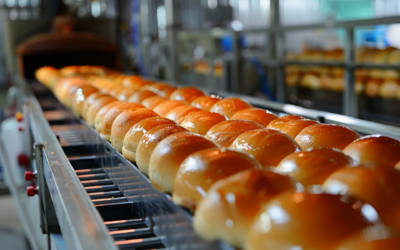Alex Brandt, Ph.D., Chief Science Officer, Food Safety Net Services
Harmful microorganisms, also known as pathogens, cause disease in humans either through direct infection or by releasing poisonous toxins. When foods and beverages become contaminated with pathogens or their toxins, it can lead to foodborne illness when they are consumed.
While nearly half (44%) of all foodborne illnesses are caused by 31 known bacteria, viruses, and parasites, the remaining half (56%) of foodborne illnesses have no identified cause. Thus, there are numerous pathogens that remain to be discovered, and much that remains to be learned about foodborne illness.
In this post, we’ll look at qualitative pathogen testing and microbiological testing of food. Contact us if you need pathogen testing for your food products.
Foodborne-Illness Outbreaks Kill 3,000 People Each Year
Contaminated foods and beverages that end up being consumed by the public have a high probability of causing a foodborne illness outbreak. Every year, 48 million cases of foodborne illness occur, leading to 128,000 hospitalizations and 3,000 deaths. A significant proportion of these are part of foodborne-illness outbreaks. Not only does a foodborne-illness outbreak threaten consumer health and safety, it can also end up being costly for the producer of that food or beverage. For example, a single foodborne-illness outbreak can cost up to $2.1 million in fines, lawsuits and legal fees for a food establishment. Moreover, food recalls are estimated to cost an average of $10 million, which includes the loss of products and the time spent to manage the recall.
In the interest of public safety, the Food Safety Modernization Act of 2011 (FSMA) introduced a shift from a reactive approach to a preventive approach for food safety. Instead of relying on reactive food recalls during an outbreak, the focus has shifted toward prevention-based controls, which include the microbiological testing of food. This helps detect the presence of pathogens in food before releasing it into the market.
Free Webinar: Understanding and Mitigating Risks of Emerging Pathogens
What is Pathogen Testing?
Pathogen testing involves applying different microbiology techniques to determine the presence and number of pathogens in food and beverage products, as well as the environments in which they are produced. It is continuously employed throughout the production process to test raw materials, intermediates and finished products to ensure that manufactured foods and beverages are free from harmful bacteria, viruses, fungi and parasites (or their toxins) that can cause foodborne illnesses.
Microbiological Testing of Food
In the early years of food and beverage pathogen testing, traditional microbiological techniques were the only options available. These techniques relied on using culture media that contained various nutrients to let microorganisms grow until they could be detected and identified. There were often several steps in the process, with several different types of culture media used, all of which were subject to analyst interpretation. Thus, these traditional methods, which are still used today, were laborious, time-consuming and subject to error.
These issues with traditional methods consequently drove the development of more rapid detection methods to improve laboratory efficiency. These rapid-detection methods can be divided into three categories: qualitative, quantitative and identification.
- Qualitative: Testing methods employed to detect whether a pathogen is present in a sample or not. A simple positive or negative result is obtained.
- Quantitative: Testing methods that give a numerical count of microorganisms in a sample. This is usually in the form of the number of colony forming units (CFU).
- Identification: Testing methods that detect cellular components, biochemical activities or gene sequences that are very specific to a particular microorganism in order to provide its full identity after it has been isolated from a food or beverage sample.
Within a manufacturing setting, food safety practices have focused mainly on the most common microorganisms that cause spoilage and foodborne illness. Consequently, manufacturers of pathogen testing assays have developed rapid testing kits that specifically focus on these most common microorganisms. Furthermore, testing assay manufacturers employ various types of technologies in their rapid testing kits, all of which have varying degrees of sensitivity, specificity and cost. Some of these key principles in choosing a rapid testing assay are discussed below. (FSNS Lab+, the contract research division of Certified Group, performs method validations for rapid testing kits.)
Free Webinar: Understanding and Mitigating Risks of Emerging Pathogens
Rapid Qualitative Methods Used in Pathogen Testing
As mentioned above, laboratories employ qualitative testing methods to detect the presence of pathogens in foods and beverages. While the food or beverage manufacturer is waiting on these results from the laboratory, they will place their products on hold. This means that they will not let the products enter distribution until all tests provide negative results. As a result, microbiological testing of food creates a bottleneck in their operations. Thus, food and beverage manufacturers will often request that laboratories use rapid methods to obtain results faster. Some of the most common types of rapid methods are discussed below.
Polymerase Chain Reaction (PCR)
PCR is a type of technology employed in many qualitative methods used to determine the presence of pathogens in foods and beverages. PCR technology detects one or more DNA sequences specific to the target pathogen through a cyclic three-step process that involves denaturation, primer annealing and polymerization. Detection is accomplished either by running the polymerized DNA on a gel to determine if DNA fragments of the expected size are observed (endpoint PCR) or by using fluorescence to detect a DNA polymerization byproduct called a fluorophore (real-time PCR). Through PCR methods, pathogens like Escherichia coli O157:H7, Salmonella and Listeria monocytogenes can be quickly and accurately detected. Due to their enhanced sensitivity, specificity and speed, PCR-based assays tend to be higher in cost than other types of rapid methods.
Immunoassay
Immunoassays are testing methods that detect the presence of pathogens in foods and beverages based on antigen-antibody interactions. Antigens are cellular components of the pathogen (usually a molecule on their surface), which can be bound by antibodies that recognize the specific chemical structure of the antigen. The sensitivity of these tests is determined by the binding strength of each antibody to its specific antigen. Likewise, the specificity of the test depends on how many different types of antigen structures to which the particular antibody is able to bind.
Two of the most used types of immunoassays are the Enzyme-Linked Immunosorbent Assay (ELISA) and the Enzyme-Linked Fluorescence Assay (ELFA). Both technologies involve binding a specific antigen to an antibody (usually coated onto a stationary surface), washing away residual sample and then binding the already-bound antigen with a second antibody that is linked to an enzyme. The formation of the antibody-antigen-antibody complex (which indicates the presence of the pathogen) is then detected by adding a substrate that the enzyme converts into a product. The formation of this product is detectable either by colorimetry (ELISA) or by fluorescence (ELFA).
Both ELISA and ELFA methods have relatively low costs compared to PCR but are more prone to sensitivity and specificity issues, depending on the assay. Thus, there tends to be a trade-off in terms of assay performance and cost.
Other Methods
In addition to PCR and Immunoassays, a number of other technologies are widely employed for pathogen-detection methods. This includes Loop-Mediated Isothermal Amplification (LAMP) and Targeted DNA Sequencing.
LAMP is similar to Real-Time PCR in that it involves detection of byproducts of the DNA polymerization process. The difference is that DNA polymerization is done with the aid of a strand-displacing DNA polymerase that initiates synthesis and two specially-designed primers that form “loop” structures to facilitate subsequent rounds of amplification through extension on the loops and additional annealing of primers. This allows LAMP to function at a single temperature, eliminating the need for the three-temperature cycling requirements of PCR. LAMP thus tends to be more resilient to inhibitors than PCR.
Targeted DNA Sequencing involves using PCR to amplify multiple DNA sequences in a target organism. These multiple PCR products are then sequenced on a next-generation sequencing instrument to determine if their DNA sequences match those of the target pathogen. By using actual DNA sequence data to determine if a pathogen is present, Targeted DNA Sequencing technologies are much less prone to errors and have even higher specificity than PCR. However, they are much more expensive and take several more hours to complete analysis due to the sequencing and data analysis time that is needed. Yet, they also provide additional information at no cost, such as the serotype or subtype of the target organism that they are designed to detect.
New Technologies Being Developed in Pathogen Testing
As researchers and scientists develop new technologies for detection of microorganisms, those technologies are evaluated by foodborne pathogen test kit manufacturers to determine if they provide an advantage over current methods. Enhanced speed, improved accuracy and reduced costs are always desired, and if a new technology provides this, it will be evaluated to determine its merits in being used to develop foodborne pathogen test kits. Many technologies that make their debut in the clinical testing space eventually are adapted for pathogen testing in foods and beverages.
One of the new technologies being evaluated for use in foodborne pathogen test kits is Droplet Digital PCR (DDPCR). While DDPCR has been around for more than a decade, it is finally starting to make an entry into the foodborne pathogen testing space. In DDPCR, PCR reactions take place in thousands of tiny partitions called microdroplets. Microdroplets are formed by encapsulating water-soluble DNA template and PCR reagents inside of water-insoluble oil droplets. These microdroplet partitions create thousands of individual PCR reactions inside of one sample well. After the PCR process is complete, each individual microdroplet is passed through a droplet reader. The droplet reader reads the fluorescent signal of each droplet and determines if it is positive for one or more DNA sequences of the target pathogen. It will then provide a count of how many positive droplets it observed. Because of this special partitioning, DDPCR has the advantage over traditional PCR in several areas, especially with regard to quantification and determining co-localization of DNA targets. Thus, in the foodborne pathogen testing space, it has been investigated for use in Salmonella quantification methods and in determining co-localization of stx and eae genes in Shiga-Toxin Producing E. coli.
A new identification technology that is quickly taking hold in the food and beverage testing space is Matrix-Assisted Laser Desorption Ionization-Time of Flight Mass Spectrometry (MALDI-TOF MS). MALDI-TOF MS is a rapid and reliable way to identify nearly every type of microorganism. It involves spotting a suspension of the microorganism on a plate, exciting it with a laser and then reading a mass spectrum of the different molecules that are emitted via the laser. The mass spectrum obtained is then compared to a database to identify the organism. Thus, MALDI-TOF MS is considered a replacement for traditional biochemical identification methods. While the equipment required to perform MALDI-TOF MS is considerably more expensive, it provides an almost instantaneous identification of a microorganism. As databases expand and equipment becomes less expensive, MALDI-TOF MS will eventually replace traditional biochemical identification methods.
How FSNS Can Help You Through Pathogen Testing
In the interest of public safety, U.S. food safety laws have been updated to prioritize testing for foodborne pathogens as a crucial aspect of food and beverage production. Ensure your compliance with FSMA guidelines with the help of Food Safety Net Services.
FSNS is a network of ISO 17025 and A2LA accredited operating laboratories. We use state-of-the-art testing methods and equipment to help you with the rapid detection of pathogens that cause foodborne illness and threaten public health. Using the highest standards in food safety and microbiology testing, we ensure the accurate detection of contaminants and the reliability of our results.
For any inquiries or questions about our microbiological testing methods, or if you would like more information, don’t hesitate to get in touch with us here, send an email to customerservice@fsns.com or give us a call at 888-525-9788.
Free Webinar: Understanding and Mitigating Risks of Emerging Pathogens




